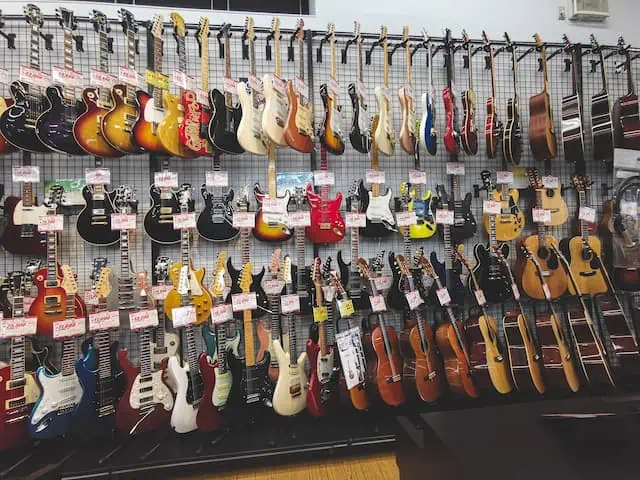When you start something new, you don’t want it to be harder than necessary. To be fair, guitar isn’t the hardest thing I’ve had to learn, it’s not even the most difficult instrument that I’ve had the opportunity to learn. But it’s not a walk in the proverbial park, either. And the more advanced you get, the harder it becomes.
Contorting your fingers into these shapes you wouldn’t usually make, learning to press down the strings enough to produce a note, the sore fingers in the beginning. That’s just the tip of the iceberg. You need to coordinate both hands to make sure you produce the right notes. Speed, accuracy, various techniques. It takes time to learn. Most of the time it’s fun, but there are things you will need to practice that just feel like a boring slog.
You will get frustrated at times, but you will find it rewarding. When you finally get it right, it’s awesome. And once you can play things easily, you can bet all the hard work was worth it. But is electric guitar easier than acoustic? I’ll look at the advantages that each guitar has, electric, acoustic, and classical, and whether electric really is the easiest. Let’s get to it.
Contents
Is Electric Guitar Easier Than Acoustic: The Short Answer- Yes
There are a few things that make an electric guitar easier to play than acoustic guitars, both steel string and classical:
- The action is lower (the distance between the strings and the fretboard) which make the strings easier to press down.
- Electric guitar necks are thinner, which is good for those with small hands, good for most guitarists really
- The body is thinner and smaller, which is good for comfort in general and is helpful for those with shorter arms
That said, you’ll see below that it’s not always as black and white as this.
A Comparison of Electric, Steel-String Acoustic, and Classical Guitars and Their Playability
Yes, there are physical factors that make certain guitars easier to play than others, but it also depends largely on your goals. It doesn’t help if you’re into fingerstyle acoustic or classical guitar, and then you pick an electric because it may be easier to play. If you’re not a purist and like to play various genres, this matters less. Here’s an in-depth look at each guitar. The pros and cons list will include specifics regarding playability first.
Electric Guitars
Electric guitars are suitable for a wide range of genres, except for those where acoustic guitars are required. Electric guitars just don’t have that beautiful crisp, full, clean tone that’s characteristic of steel string acoustics, though through some effects you can get something close to the soft, mellow tone of a classical guitar. There are even ways to make an electric sound kind of like a steel string acoustic. But never exactly like either of those.
You may get away with using a semi-hollow or hollow body electric guitar to get the best of both, but they are quieter than acoustic guitars when unplugged. This may be a good thing, however, if you want to practice quietly.
The main genres that electric guitars are used for include:
- Rock
- Metal
- Fusion
- Jazz
- Blues
- Pop
- Folk
- Country
- Funk
So as you can see, they are versatile whether they’re the main instrument or laying down lead or harmony parts. With pedals and combo amps, you can use a range of effects to customize your sound. The thinner neck and lower action makes them ideal for fast playing, whether you’re making jazz or playing a spectacular solo.
And if you’re into rock, an electric does distortion and overdrive so well, after all, a lot of them are designed specifically for it. But you’ll find plenty geared for clean playing that suits jazz, funk, folk and pop. And you’ll find plenty made for both.
Pros:
- Thinner neck
- Lower action
- Very quiet when unplugged (including semi-hollow and hollow body guitars, albeit a bit louder than solid body guitars)
- Easy to connect to effects pedals
- Great for soloing
- Power chords sound amazing
- Easier for guitarists with smaller hands and shorter arms
- Strings are easier to bend (if you have light gauge strings) and hammer on
- String changes are very easy
- Adjustments are easy
Cons:
- They are heavier
- Even if you tweak the sound, they will never sound 100% acoustic
- Less suited to finger picking as the strings are closer together, but it isn’t impossible
- The strings aren’t soft
- If you want to upgrade your guitar, it can be tricky replace things like the pickups yourself
Acoustic Guitars
Steel-string acoustic guitars can vary so much in tone and come in different sizes. The type of tonewood, the thickness of the neck, size of the body, the type of lacquer, the action, and the strings affect the way an acoustic guitar sounds.
Things that make steel-string acoustics harder to play, generally make them sound better. Although you can get light gauge strings, for a good full sound, heavier gauge strings are beneficial. Even with the action, higher equals more resonance. The thicker neck makes for a better tone. The strings are spaced further apart than on an electric making finger picking much easier.
While smaller acoustic guitars like the parlor guitar may be easier for most guitarists, especially us smaller guitarists, they aren’t as full-sounding or as resonant and loud as bigger guitars like the dreadnought or jumbo guitars. It’s for this reason that as petite as I am, I will never let go of my dreadnought. That said, if you only do fingerstyle type stuff, a parlor guitar or concert guitar works fine. But if you like to strum, it’s best to get at least a grand concert guitar for a fuller sound.
Acoustic guitars can be fully acoustic or semi-acoustic. The former can be plugged into an amp (preferably an acoustic amp) or PA system, and even use pedals too.
Genres that use steel-string acoustic guitars:
- Folk
- Bluegrass
- Jazz
- Rock
- Pop
- R&B
- Fingerstyle
- Ragtime
- Mariachi
- Blues
While you’ll hear acoustic guitars as the star of the show in some of these genres, they really play only supporting roles in others. Power chords sound pretty cool on a steel string acoustic, but it’s just not as good as an electric with distortion. So in rock, you’ll only find acoustics during the more mellow songs that require a clean, more gentle sound.
Pros:
- Lighter
- Better for fingerstyle guitar
- Come in a range of sizes
- Suited to a wide range of genres
- You can play them unplugged, even for a small audience
- Semi acoustic guitars do well with larger crowds if you have a good sound engineer and decent sound system
Cons:
- They are bigger which is problematic for smaller guitarists
- The neck is wider, which can make it difficult for guitarists with small hands
- The action is higher, so it’s harder to push down the strings
- The strings themselves are harder (than classical guitars)
- More fragile than electric guitars (solid body electrics anyway)
- Upgrading your guitar is harder since the quality and type of wood influence so much (and a luthier is recommended for upgrading the tuning machines or bridge)
Classical Guitars
Classical guitars have nylon strings. From a playability perspective, this is good for beginners. Your fingers will hurt less since they are the softest strings. But in order to do classical guitar music justice, the neck is broader, the action higher, and the body bigger for a full resonant sound.
Just as with steel string acoustics, classical guitars are also made from different tonewoods and the actual wood can vary in thickness. A heavier build will result in less resonance. While they come in different sizes, it’s not like the sizing you would find for steel string acoustics. You just get a classical guitar that comes in full size, ¾ size, ½ size, or ¼ size. The smaller the guitar, the less full, resonant, and loud the guitar is. Classical guitars also come as acoustic or semi acoustic.
The genres that use a classical guitar:
- Classical guitar
- Fingerstyle
- Flamenco
- Bossa nova
- Jazz
- Pop
- Country
Classical guitars as you can see are used in a variety of genres and take center stage with classical guitar, bossa nova, and flamenco. You don’t need to worry that if you choose to play a nylon string guitar that you’re only going to be able to play one genre. I, in any case, am an advocate for exploring creativity and if that means using your classical guitar to play metal riffs, go right ahead!
Pros:
- Classical guitars are the lightest
- They are built for finger picking (wide neck)
- Soft strings
- You can play unplugged and unmiked for a small audience
- Suitable for various genres
Cons:
- The neck is thick and wide, which is problematic for those with small hands
- The body is quite big, which is problematic for smaller guitarists
- The action is the highest, so the strings are hard to press down
Things to Keep in Mind When Buying a Guitar
What Genre/s Do You Want To Play
The main question you need to ask yourself is what genre you want to play.
The simple fact is that even with a classical guitar or an electric guitar, you will have sore fingers in the beginning. But consistent practice every day will give you calluses within about 2 to 3 weeks. Then it just requires maintaining those calluses through regular playing.
You are going to have to develop accuracy and muscle memory. Your fingers will learn this on whichever guitar you pick. If you pick an electric, your fingers will learn that spacing. The same goes for a steel string acoustic and classical guitars. If you want to play fast, your muscle memory, accuracy, and speed will develop for the guitar you play.
The genres you prefer will also largely affect how you need to play that guitar. The different types of guitars are built for specific genres. Electric guitars are versatile, but they are designed more for use with a pick. Classical guitars are designed to be played with your fingers, since classical guitar, bossa nova, and flamenco are generally played via finger picking. Steel string acoustic guitars have the best of both worlds.
Your Size
If you’re a petite person, you may struggle with a large guitar. It’s not impossible, though. I barely make 5”2. I don’t think my hands are tiny, they seem to be the same size as some of my friends, who are taller than me, although these friends are considered short too. But my hands are still small hands.
I manage my dreadnought just fine. Standing is much more ergonomic for my right shoulder, since I have to lift my shoulder to get my arm over the body of the guitar to reach the strings optimally when I sit.
There’s also the issue of stretching your fingers for those interesting chords or for playing crazy riffs. You can get around things sometimes by using a little creativity. I’m sure all my fellow short people fully understand when I say we learn to do some things differently. That’s true of every day things, and also true of playing guitar.
Of course, there are ¾ options for popular guitars like dreadnoughts and concert guitars. These will have smaller bodies and/or shorter scale lengths (distance between the nut and bridge). But as we know, that affects the tone. A full-size parlor, concert, or auditorium may be the answer. Plus, with semi acoustic guitars you can adjust the EQ to boost the bass a bit as these can be treble heavy. But I think you may find you enjoy the tone of these smaller guitars if you get a good quality one.
You also get electric guitars that have shorter scale lengths. This generally does also mean that the guitar won’t have that full-bodied growl when you crank the overdrive, but if you’re buying online, read the reviews, listen to samples. You may be surprised how good these can sound.
What You Expect in a Guitar
Maybe you’re looking to buy your first guitar or buy an electric after you’ve decided the acoustic isn’t for you. If this is the case, buying a beginner guitar or budget guitar is likely what will suit you best. I do recommend that you do your homework, however. A decent guitar, even an entry level guitar, can last you quite a while. Well into your guitar journey in fact.
If you buy a totally rubbish guitar, it will only be for that first year or so, and then your improved skill and ear will demand something better. You may also find that it just sounds bad, never stays in tune even after the strings have settled, and that parts even break. So be discerning.
While you can do some things to upgrade an acoustic, like buy better strings and replace the tuning machines and that, the body of the guitar, and the neck, is what you’ve got. The quality of the wood matters, as does the type.
You have a little more leeway with electric guitars. Although the wood does have an impact on the sound, it’s minimal in the case of solid body guitars. Upgrading the pickups and strings will get you very far. But you do want the guitar to be put together properly.
So again, be discerning when you buy.
My Top Recommendations for Electric, Steel String Acoustic, and Classical Guitars
I already linked articles that have a lot more buying options, so if you want a bigger list, check those out. But here are a few that I think would be good for beginners. All of these guitars are said to have good playability. That said, you can always improve the playability by setting up your guitar. Two of the easiest ways to make your guitar easier to play is adjusting the truss rod and action.
Electric Guitars
Ibanez GRX70QATKS 6 String Solid-Body Electric Guitar
If you’re more into rock and metal, the GRX70QATKS is a good starting point. Many people agree it sounds more like a $500 guitar. The neck is smooth, and the action is low, so it allows you to move up and down the neck and fret notes easily. You get a poplar body, a maple neck and pine fretboard. You get two ceramic humbucker pickups and a ceramic single coil with a 5-way pickup selector. This guitar can do smooth well, but those pickups will add more than decent grit for overdrive and distortion.
Choose from transparent violet sunburst, transparent green sunburst, transparent red sunburst, transparent blue sunburst, transparent black sunburst, or sunburst. Ibanez offers a 1-year warranty on their guitars.
Squier Affinity Starcaster
If you want a budget-friendly semi-hollow electric that sounds great, the Starcaster is a good option. The C-shaped neck is smooth and comfortable to play, the action is fairly low, so the strings are easy to press down. The body is laminated maple with a maple neck and maple fretboard. You get two humbuckers with a 3-way pickup switch and the master tone and volume knobs. This guitar distortion well, and it does clean playing well. Great versatility.
Choose from 3-color sunburst, candy apple red, or olympic white. Fender provides a -year warranty on Squier guitars.
Get the Squier Affinity Starcaster from Sweetwater.
Ibanez Artcore AF75 Hollowbody Electric Guitar
You’ll have to fork out a little more for this one, but hollowbody guitars are a bit more expensive. You can’t go wrong with AF75. While the body is big for resonance, the neck plays well. The body is linden with a nyatoh neck and laurel fretboard. You get two humbuckers with a volume and tone knob for each, and a 3-way pickup selector. This hollowbody sounds just like a hollowbody should and will last you well into your guitar career, being suitable even for guitarists who perform. Choose between transparent red sunburst or jet blue sunburst.
Get the Ibanez Artcore AF75 at Sweetwater.
Ibanez Mikro GRGM 6 String Solid-Body Electric Guitar
If you’re petite or buying for a younger guitarist, the 22.2” scale length will really help. It’s not a toy by any means, but is simply a smaller Ibanez guitar. The neck is easy to play and the smaller body is comfortable and lightweight for smaller guitarists. It has quite a balanced tone that belies the small size.
The body is basswood and the fretboard is maple. You get a humbucker pickup with a 5-way pickup selector (so it has a split coil function to hear the humbuckers as single coils), and a volume and tone knob. Choose between candy apple red, jewel blue, blue burst, metallic purple, or orange burst.
Acoustic Guitars
Gretsch G9500 Jim Dandy 24″ Flat Top Acoustic Guitar
If you want a smaller guitar, the Jim Daddy is a parlor guitar with a scale length of 24”. Along with its vintage look, it also has a vintage sound. The top and back is agathis and the rest of the body is basswood with x-bracing for resilience and good tone. The neck is nato and the fretboard is walnut. Get it in frontier stain or 2-color sunburst. Fender offers a 2-year limited warranty on Gretsch acoustic guitars.
Fender FA-125 Dreadnought Acoustic Guitar
For a full, resonant tone, consider the FA-125. Many say it sounds better than its price point suggests, and that the action is surprisingly low. The body is laminated basswood with a laminated spruce top. The neck is nato with a walnut fretboard. Choose between black and natural. Fender offers a 2-year limited warranty on their acoustic guitars.
Oscar Schmidt OG10CE Cutaway Acoustic-Electric Guitar
If you’re in the market for a semi acoustic steel string guitar, here you go. This concert guitar is suitable for even more petite players and the cutaway shape allows you to reach the lower frets easily. Many feel that this guitar sounds better than the price suggests, and that even more difficult chords are easy to play on this guitar.
The body is mahogany with a spruce top. Choose from natural, flame transparent green, flame transparent blue, flame transparent purple, flame transparent red, flame yellow sunburst, flame transparent black, or USA flag graphic. Oscar Scmidt acoustic guitars carry a limited lifetime warranty.
Classical Guitars
Takamine GC1 Classical Acoustic Guitar
The GC1 is a full-scale guitar with a medium body. If you struggle with a bigger body but want a full scale neck, then this is a good option. The quality construction of this guitar and the sound are worth more than the asking price. The mahogany body is laminated, as is the spruce top. The neck is mahogany with a rosewood fretboard. Takamine offers a limited lifetime warranty on their guitars.
Cordoba Mini II
Okay, so this guitar is more like a short scale steel string guitar, but with nylon strings, as opposed to a classical guitar. By that, I mean it has the nut has the width of a steel string acoustic. I wouldn’t really recommend it for proper classical guitar techniques. But if the smaller size is more what you’re after, here you go. You can play classical guitar pieces on this guitar if you want to, and it should still sound very good, albeit not quite authentic.
The scale length is 22.9”. You can find the Mini II in all-mahogany, flamed mahogany, or the model with the solid spruce top and ebony sides and back with its cutaway shape. These guitars have a deeper body for a fuller tone, so unlike some small nylon string guitars which sound more like a ukelele, these sound almost like a full scale nylon string guitar. If I’m not mistaken, the Mini II would fall under a 3-year limited warranty.
Yamaha CGX102 Classical Guitar
This is a semi acoustic classical guitar. It’s in their beginner range, but the CGX102 has a beautiful tone that doesn’t sound cheap. It also has proper classical guitar nut width, so it’s good for those of you who really want to play classical guitar and/or have big hands and fingers. You’ll get a good few years out of it. It has a nato body with a spruce top. The neck is nato and mahogany with a rosewood fretboard. Yamaha offers a 1-year warranty on their guitars.
Get the Yamaha CGX102 at Sweetwater.
Conclusion
In short, we can say, yes, electric guitar is easier than acoustic for beginners. But to summarize, it depends on the type of genre you want to play. If you want to play fingerstyle guitar, the narrowly spaced strings of an electric guitar is not going to be very helpful. Impossible? No. But difficult, yes. But if you are into the genres that electric guitar is used in, and want to adapt other types of guitar music to the electric, go for it.
Many guitarists end up having more than one guitar anyway. If you love guitars, and you can afford it, chances are you’ll be the same.
And you can then have a variety. Never sell yourself short. You are capable of learning a particular style of guitar music on the guitar designed for it. Whether it be an acoustic or classical guitar, or the electric. And if you decide to learn on an electric to ease into it, and because let’s face it, electric guitars are awesome, you are fully capable of learning new styles of playing once you want to expand your skills and repertoire.
Happy jamming!





